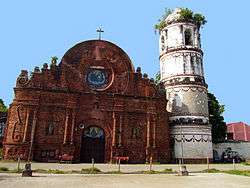Tumauini Church
| Tumauini Church | |
|---|---|
|
San Matias Parish Church Iglesia Parroquial de San Matías | |
 Facade and cylindrical belltower of Tumauini Church | |
.svg.png) Tumauini Church Location in Isabela, the Philippines | |
| 17°16′31″N 121°48′26″E / 17.275395°N 121.807124°ECoordinates: 17°16′31″N 121°48′26″E / 17.275395°N 121.807124°E | |
| Location | Tumauini, Isabela |
| Country | Philippines |
| Denomination | Roman Catholic |
| History | |
| Founded | 1707 |
| Founder(s) | Francisco Nuñez, O.P |
| Dedication | Saint Matthias |
| Architecture | |
| Status | Parish church |
| Functional status | Active |
| Heritage designation | National Cultural Treasure |
| Architect(s) | Fr. Domingo Forto |
| Architectural type | Church building |
| Style | Baroque |
| Groundbreaking | 1783 |
| Completed | 1805 |
| Administration | |
| Archdiocese | Tuguegarao |
| Diocese | Ilagan |
| Province | Tuguegarao |
| Clergy | |
| Archbishop | Sergio Utleg |
| Bishop(s) | Joseph Amangi Nacua |
The San Matias Parish Church (Spanish: Iglesia Parroquial de San Matías), commonly known as Tumauini Church, is a Roman Catholic church in the municipality of Tumauini, Isabela, Philippines within the jurisdiction of the Roman Catholic Diocese of Ilagan. It became a separate parish independent from Cabagan under the advocacy of Saint Matthias in 1751.
The church, known for its brick Baroque-style architecture, was declared a National Cultural Treasure by the National Museum of the Philippines. Together with the churches of Boljoon, Guiuan, Loboc and Lazi, the Tumauini Church has been considered for the UNESCO World Heritage Tentative List since 2006 under the collective group of Baroque Churches of the Philippines (Extension).
History
The first church made of nipa and other light materials was built by the Dominican priest Francisco Nuñez in 1707, and dedicated to Saint Matthias.[1][2] Tumauini became an independent parish from Cabagan in 1751.[1] The current church was built under the auspices of another Dominican, Domingo Forto, in 1783 and later continued by the priest Antonio Herrera in 1788.[3] In constructing the church, Forto hired artisans from as far south as Pampanga.[3] It was completed in 1805.[1]
The church was damaged during the Second World War; a faithful reconstruction programme followed, with undamaged parts of the church building retained.[4]
Features
Tumauini is an ultra-baroque church known for its extensive use of red bricks on its exterior and interior ornamentations.[3] Brick was used due to lack of good quality stones in the area.[5]
Façade
The church building is made entirely of ornately-designed red bricks in its façade and its interior walls.[4] A closer look at the brick façade shows numbers and dates for the correct sequence of the bricks in Forto's design.[3] The façade is flanked by two pseudo-Corinthian columns and niches, one located above the entrance and the two remaining larger niches on each side of the columns.[3] The church's circular pediment is unique relative to all other churches built during the Spanish Era.[3]
Belfry
Attached to the church's façade is a unique cylindrical belfry built in 1805.[4][6] It is the only known Spanish colonial era cylindrical tower in the country.[7] The tiered belfry notably resembles a wedding cake.[8][9]
The bell housed within has bullet holes but was never recast.[10]
Convento
The ruins of the church's convento (clergy house) are located on the gospel side of the church.[4]
Historical and cultural declarations
Tumauini Church was declared a National Cultural Treasure by the National Museum of the Philippines. The National Historical Commission of the Philippines declared Tumauini Church a National Historical Landmark on February 24, 1989.[2]
It is also being considered for addition to the UNESCO World Heritage Sites of the Philippines under the Baroque Churches of the Philippines (Extension) with the churches of Patrocinio de María in Boljoon, Cebu; La Inmaculada Concepción in Guiuan, Samar; San Pedro Ápostol in Loboc, Bohol and San Isidro Labrador in Lazi, Siquijor.[4]
Notes
- 1 2 3 National Historical Institute 1993, p. 176
- 1 2 Mangubat, Kaye (September 20, 2012). "Five unique churches in the Philippines". Yahoo News Philippines. loQal.ph. Archived from the original on September 22, 2012. Retrieved September 11, 2014.
- 1 2 3 4 5 6 Gaspar, Roger (1996). "Flowers in Brick: The Tumauini Church in Isabela". Archived from the original on August 1, 2009. Retrieved October 9, 2014.
- 1 2 3 4 5 "Baroque Churches of the Philippines (Extension)". UNESCO World Heritage Centre. Retrieved October 9, 2014.
- ↑ Lim-Castillo 2007, p. 117
- ↑ Villalon, Augusto. "Significant Examples of Church Architecture in the Philippines". National Commission for Culture and the Arts. Retrieved September 11, 2014.
- ↑ Ortiguero, Romsanne (March 17, 2013). "Why visit Isabela this summer? 10 great reasons to check out the Queen Province of the Philippines". Interaksyon. Retrieved September 11, 2014.
- ↑ Alba, Reinerio (September 29, 2003). "The Restoration of 26 Philippine Churches". National Commission for Culture and the Arts. Retrieved September 11, 2014.
- ↑ Enriquez, Marge (April 10, 2011). "Edifices of a people's faith". Philippine Daily Inquirer. Retrieved September 14, 2014.
- ↑ Jose, Regalado Trota. "What to do with an Old Church (or Mosque or House)?". National Commission for Culture and the Arts. Retrieved October 9, 2014.
Bibliography
- Lim-Castillo, Pia (2007). "Eggs in Philippine Church Architecture and its Cuisine". In Hosking, Richard. Eggs in Cookery: Proceedings of the Oxford Symposium of Food and Cookery 2006. Oxford Symposium. p. 117. ISBN 9781903018545.
- Historical Markers: Regions I–IV and CAR. Manila: National Historical Institute (Philippines). 1993. p. 176. ISBN 9715380611.
External links
| Wikimedia Commons has media related to Tumauini Church. |